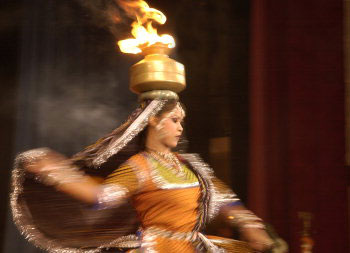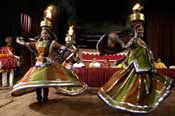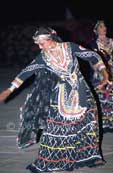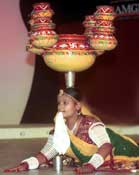






Rajasthani dances are a spectacular celebration of life and color. Festivals are incomplete without dance performance. The ambience is evoked by the rhythmic clash of the long, painted sticks, the swaying and swirling of the performers to every beat of the drum. Vigorous dance with folk ballads and sharp pirouetting and brandishing of swords flares out in a blaze of color and movement. There are various folk dances for all age groups (5-60 yrs). These are famous art forms practiced in different parts of Rajasthan.
Bhavai
One
of the state's most spectacular performances, it consists of veiled women
dancers balancing up to seven or nine brass pitchers as they dance nimbly,
pirouetting and then swaying with the soles of their feet perched on the top
of a glass or on the edge of the sword. There is sense of cutting edge suspense
and nail biting acts in the dance.
Chari
Gathering
water is part of everyday life of women of Rajasthan. The women go many miles
to collect water for their families and their joy is reflected through the
Chari Dance. Dancers choreograph deft patterns with their hands while balancing
brass pots on their heads.
The performance
is made more picturesque with the flames
from cottonseeds set
alight, so that the bobbing
heads create
streaks of illuminating patterns as they move effortlessly
around the floor.
Gair
There
are several variations to this picturesque dance form that is performed by
both men and women. The men wear long, pleated tunic that open out into full
length skirts as they move first in clockwise then anti clockwise directions,
beating their sticks to create the rhythm when they turn. Originally a
Bhil dance and performed at
the time of Holi, its variations are the Dandi Gair in the Marwar region and
Geendad in the Sekhawati region.
|
Best
viewed in Internet Explorer 5+ at a screen resolution of 1024 by 768
Pixels
Web-Site designed & maintained by WEB
SOLUTIONS
|
 Ghoomar
Ghoomar
A
community dance
of the Rajputs, performed by the women of the house and traditionally out
of bounds for the
men, it uses simply, swaying movements to convey the spirit of any auspicious
occasion. There
is, however, an amazing grace as the skirts flair slowly while the women twirl
in circles, their faces covered by the veil.
All
women, young or old, participate in Ghoomar dance, which can continue for
hours into the night. As one of the traditional rituals, a bride is expected
to dance Ghoomar on being welcomed to her husband's home.
Kachhi Ghodi
Originated from the bandit regions of Sekhawati,
the dance is performed for the entertainment of the bridegroom's party. Dancers
wear elaborate costumes that resemble them riding on du mmy
horse. A vigorous dance, it uses mock fights and the brandishing of swords,
nimble sidestepping and pirouetting to the music of fifes and drums. A ballad
singer usually sings the exploits of the bandit Robin Hoods of Rajasthan.
mmy
horse. A vigorous dance, it uses mock fights and the brandishing of swords,
nimble sidestepping and pirouetting to the music of fifes and drums. A ballad
singer usually sings the exploits of the bandit Robin Hoods of Rajasthan.
Kalbeliya
One
of the sensuous dance forms of Rajasthan, performed by the Kalbeliyas, the
snake charmers community. The sapera dancers wear long, black skirt embroidered
with sliver ribbons.
As they spin in a circle,
their body sways acrobatically, so that it is impossible to believe that they
are made of anything other than rubber. As the beat increases in tempo, the
pace increases in such a pitch that it leaves viewer as exhausted as the dancer.

Terahtaali
A
devotional form of dance practiced be the Kamad community, to honor their
folk hero Baba Ramdev, it consists of women sitting on the floor before his
image.
Tied to various parts of their body are thirteen cymbals, which they strike with the ones they hold in their hand. Their hands perform various arabesques while they do this and for effect, they may also balance pots on their hands and hold a sword in their mouth.